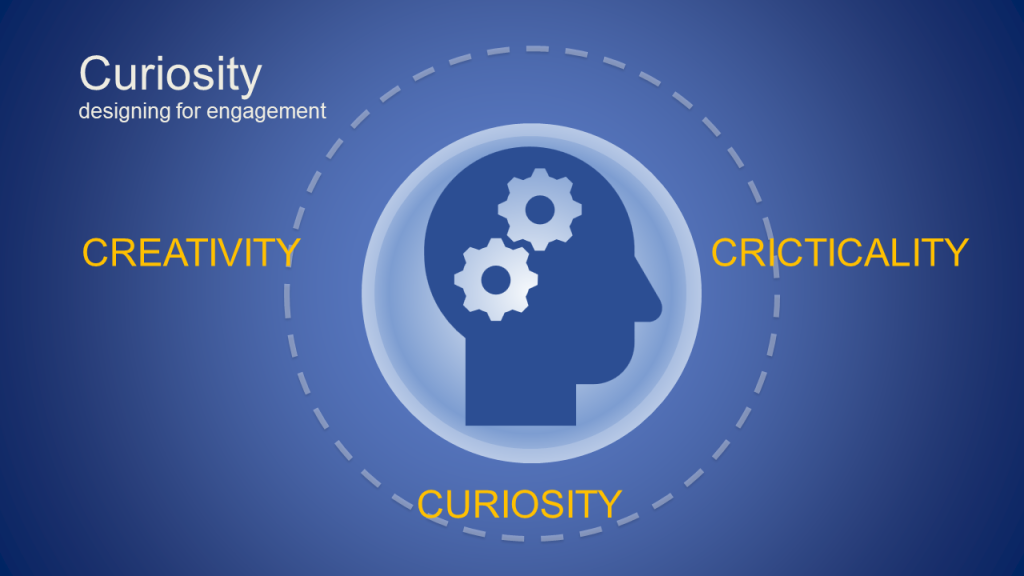
In this post I explore creativity and critical thinking and how they connect with the fostering of curiosity.
This post continues my exploration of curiosity as a state of learning in which learner motivation and agency are central. Following on from the earlier post on curiosity, the need to maintain the learner’s motivation (more than just interest) leads the academic designer to look at creating situations which ensure learning is situated and open-ended.
Problems and possibilities
Creativity and criticality relate to each other through patterns of divergent and convergent thinking.
If creativity is about possibility thinking and asking “What if?” through engagement with problems (Burnard, Craft & Cremin, 2006), critical thinking is about evaluating or weighing up possible options and answers. Learning is a process of making judgements – asking about the strengths or weaknesses of an argument, looking for alternative perspectives or answers, deciding what is or isn’t significant, or what is useful to know.
Divergent and convergent patterns of pedagogic design are the basis of design thinking in which the learner fluctuates through phases of ideation, application, and synthesis. From possibility thinking the learner applies and evaluates what they know to form firmer conceptions of knowledge. Learning is equally active, cognitive and meta-cognitive.
Open-ended learning
Iterative patterns of divergence and convergence or problem finding and problem solving suggest learning is a matter of forming conclusions and finding definitive answers. In reality, and in the case of authentic learning theory (Rule, 2006), this is not the case.
The implication of this is that the learning designer needs to situate learning so that learning always has somewhere to go: new, emergent ideas and understanding need to be continuously applied, tested and reworked. Acts of learning should seed learner curiosity by design.
This conflicts with a teaching and learning culture in which summative assessment is positioned as an acceptable and dominant motivational force – it feels so cynical and lazy to accept surface learning as the defining force in learning design.
Designing for curiosity through feed forward
Personally, I think effective assessment should always be formative – the act of assessment is itself should be a significant act of learning. Summative assessment should sit within that frame when it is necessary to make academic judgements about the learner’s performance to date, however, if the formative flow is allowed to colour the assessment activity, it becomes clearer how designing for learning can help to carry the learner forward.
The trouble is the act of summative assessment is so often reified by both the teacher and the learner. This is well-known in the literature on feedback design.
Fostering a state of learner curiosity, arguably, is as necessary as feedback that that is designed to feed forward. Feed forward, perhaps, is the obvious opportunity to reinvigorate a learner’s curiosity. Rather than telling a student about what they got wrong, feedback can emphasise possibility thinking. For example, if the assessment problem specified variable ‘x’, feedback can ask or explore what would happen if variable ‘y’ had been specified. Or, as in good feed forward design, provide intrigue in terms of how the learner might apply the theory, skill or knowledge in a later module or activity.
Don’t leave me in the lurch – inspire me
If learning is always an unfinished symphony of possibilities, it follows that the academic designer is faced with leaving the learner ‘hanging’ and dissatisfied. On the other hand, they can leave them wanting more by assigning each learner a sense of their agency: an expectation that they can reflect further to make sense of their experience and draw out further meaning.
This takes us to meta-cognition and reflective learning. Beyond learning as an act of making sense (creating a general sense of understanding), Moon points us to the need to create expectation and space to go further. Only then can making meaning, and then working with meaning, lead to transformative learning.
Curiosity, then, seems to have a strong connection with the desire to apply learning with a strong sense of agency to make meaning.
References
Burnard, P. , Craft, A. & Cremin, T. (2006). Documenting ‘possibility thinking’: A journey of collaborative enquiry. International Journal of Early Years Education. 14.
Moon, J. (2003). Reflection in learning and professional development: theory and practice. Logan Page.
Rule, A. (2006). Editorial: the components of authentic learning. Journal of Authentic Learning, 3 (1), 1-10.
